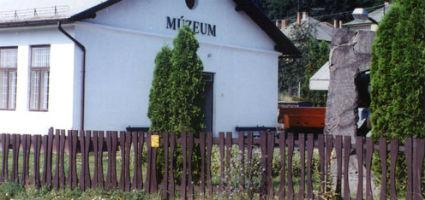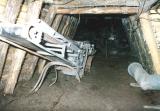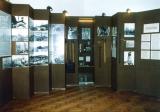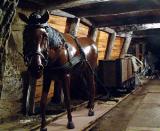2024. April 24. Wednesday
Mining Exhibition Space of the Nógrád Historical Museum - Salgótarján
 |
Address: 3100, Salgótarján Zemlinszky Rezső út 1.
Phone number: (32) 520-700, (32) 420-258
E-mail: banyamuzeum@gmail.com
Opening hours: 01.04-30.09.: Tue-Sun 9-15
01.10-31.03.: Tue-Sun 10-14 |
Just like all other industries, the Coal Mining Trust of Nógrádi wanted to establish its own mining museum through the co-operation of the Town Council, the County Council and the Tourist Office. In 1965 the purpose of the museum was to maintain history of the mining and to represent modern mining as well. The museum collects and exhibits the relics, mining tools and appliances of the work that had been accomplished in the region.
It became known in 1964 that an underground museum would be established in the town. According to Jenő Faper mining engineer the trust in its plan was led by a decision to provide an opportunity mainly to the youth and also to visitors coming to the town to get to know more about the 100 years of history of mining in the region.
The only possible place was the József mineshaft that remained in its original state. After its ceasure in 1951 the shaft was used by rescue teams that made practicing paths in the well aired system. A part (280 metres long) of this space was turned into a museum in which visitors can get an entire picture of the mine and its technical equippments.
The first underground mining museum of Hungary (second in the whole of Europe) was opened on 30th April 1965.
It is necessary to mention the names of those who supported the case of the museum and contributed much to its establishment. These were museum director Dr. Jenő Faller of Sopron; dierector of the mechanical department Henrik Adorján, chief engineer Károly Magyarfy; geologist dr. Lajos Bartkó, agricultural engineer Jenő Liptay and Béláról Tóth -, akik kezdetektől fogva az ügy mellé álltak és segítették a múzeum megvalósulását. Later museum director Zsuffa Miklós, chief engineer László Gyula, director Morvai Ernő and museum manager Kicsiny Miklós played an important role in the development of the museum.
The National Monument Authority declared the museum - the original part of the former József shaft - to be a national monument.
A mining history exhibition was opened in the museum in 1986, on the 125th anniversary of coal mining in Nógrád. The new museum - remembering the founder - took the name of József Pothornik Mining Museum.
On 1st April 1993 the museum was transferred to the care of the Historical Museum of Nógrád. In 1995 the museum renewd the locomotives and transport carriages found in the open-air museum, 13 vehicles are shown on three pairs of railways to the visitors.
On 1st December 2000 an extended open-air macjchine park was opened on the yard of the mining museum. A diminished (1:6) shaft tower was handed over in 2001. Time has proven that the museum plays an important role in the life of the town and the county, not only because of its work of tradition maintainance, but also as an institute documenting the history of the profession.
Good luck!
dr. Ferenc Szvircsek
It became known in 1964 that an underground museum would be established in the town. According to Jenő Faper mining engineer the trust in its plan was led by a decision to provide an opportunity mainly to the youth and also to visitors coming to the town to get to know more about the 100 years of history of mining in the region.
The only possible place was the József mineshaft that remained in its original state. After its ceasure in 1951 the shaft was used by rescue teams that made practicing paths in the well aired system. A part (280 metres long) of this space was turned into a museum in which visitors can get an entire picture of the mine and its technical equippments.
The first underground mining museum of Hungary (second in the whole of Europe) was opened on 30th April 1965.
It is necessary to mention the names of those who supported the case of the museum and contributed much to its establishment. These were museum director Dr. Jenő Faller of Sopron; dierector of the mechanical department Henrik Adorján, chief engineer Károly Magyarfy; geologist dr. Lajos Bartkó, agricultural engineer Jenő Liptay and Béláról Tóth -, akik kezdetektől fogva az ügy mellé álltak és segítették a múzeum megvalósulását. Later museum director Zsuffa Miklós, chief engineer László Gyula, director Morvai Ernő and museum manager Kicsiny Miklós played an important role in the development of the museum.
The National Monument Authority declared the museum - the original part of the former József shaft - to be a national monument.
A mining history exhibition was opened in the museum in 1986, on the 125th anniversary of coal mining in Nógrád. The new museum - remembering the founder - took the name of József Pothornik Mining Museum.
On 1st April 1993 the museum was transferred to the care of the Historical Museum of Nógrád. In 1995 the museum renewd the locomotives and transport carriages found in the open-air museum, 13 vehicles are shown on three pairs of railways to the visitors.
On 1st December 2000 an extended open-air macjchine park was opened on the yard of the mining museum. A diminished (1:6) shaft tower was handed over in 2001. Time has proven that the museum plays an important role in the life of the town and the county, not only because of its work of tradition maintainance, but also as an institute documenting the history of the profession.
Good luck!
dr. Ferenc Szvircsek
|
Programmes
|
|


